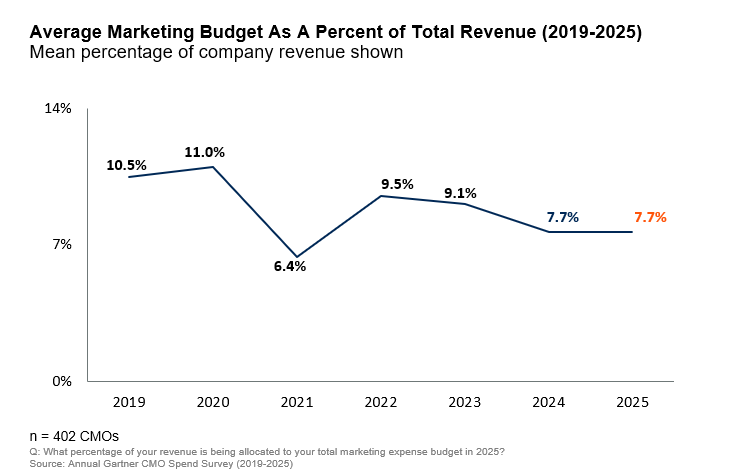Marketing budgets are holding steady for a second consecutive year, according to new data from Gartner. The 2025 CMO Spend Survey, released during the Gartner Marketing Symposium/Xpo in London, shows marketing budgets remain flat at 7.7% of total company revenue—unchanged from 2024. The findings suggest CMOs are being forced to do more with less, turning to technology and automation to stretch stagnant resources.

The survey, conducted between February and March 2025, gathered insights from 402 senior marketing leaders in North America, the UK, and Europe. Most respondents represented companies with annual revenues exceeding $1 billion. Despite relative budget stability, nearly six in ten CMOs surveyed said their funding is insufficient to meet strategic goals—down slightly from last year but still a notable majority.
Ewan McIntyre, VP Analyst and Chief of Research for Gartner’s Marketing Practice, said the figures reveal an uncomfortable truth: “Marketing spending has stalled at a level that falls short for many CMOs.” He warned that macroeconomic pressures could lead to further in-year cuts.
The survey highlights a broader shift among marketing leaders toward efficiency. CMOs are now prioritizing productivity gains, with a growing reliance on data, analytics, and AI tools to help bridge the gap between ambition and available resources. Gartner’s data shows that 49% of respondents report improved time efficiency from GenAI investments, while 40% cite better cost efficiency. Nearly three in ten say AI has increased their capacity to produce more content or manage more tasks without expanding budgets.
While AI-driven productivity is a clear trend, budget allocation still reflects traditional priorities. Paid media continues to be the largest single line item, consuming 30.6% of the average marketing budget. But rising media costs are eroding the value of that spend, according to Gartner, leaving marketers with shrinking returns for every dollar invested.
As a result, CMOs are looking to cut costs elsewhere. Thirty-nine percent plan to reduce their reliance on external agencies, a move made easier by generative AI’s growing role in content creation and strategic planning. The same proportion also expect to scale back labor costs through role consolidation and headcount reductions.
These findings arrive at a time when marketing organizations are under increasing pressure to show clear financial impact. While the promise of AI and data analytics is substantial, its effectiveness in driving measurable business outcomes remains under scrutiny. For marketing professionals, the message is clear: budgets are unlikely to grow in the near term, and success will depend on their ability to extract more value from existing investments.
The stagnation in marketing budgets also reflects a broader pattern across corporate functions, as companies brace for economic uncertainty and reassess spending across departments. For CMOs, this creates an imperative to link marketing activity more directly to business performance—especially in areas like customer acquisition, retention, and revenue generation.
As marketing teams adapt to a leaner operational model, the data suggests that leaders are rethinking how work is distributed, what roles are truly necessary, and how technology can supplement human input. This re-calibration could reshape agency relationships, internal staffing models, and the future role of creative development.
Whether these changes will lead to long-term efficiency or a gradual erosion of marketing effectiveness remains to be seen. What’s clear is that the current environment is forcing marketers to rethink how they allocate every dollar—and whether every function justifies its cost.

